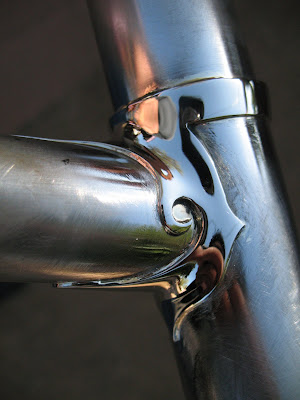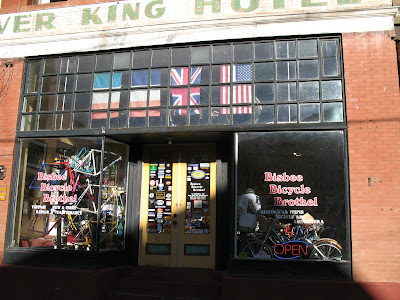
9PM, 23 Nov 2009

1AM, 24 Nov 2009
"Yeah you get it"
For David Bohm there are those that "get it" and those that "don't get it". In our predominantly cyclocentric conversations, those that "get it" are those that know that bike fit is more important than the weight of the bike. That the quality of a ball bearing (based on roundness, surface smoothness, strength etc) is more important than whether it is made of steel or ceramic. That the stiffest frame does not make it the best handling frame for all situations.
We wonder why so many people suck up market propaganda without hesitating to think about what they are being sold. Clearly it happens in all areas of life and not just the bicycle world. And most of us are guilty of it to some degree.
Then again there are those that don't appreciate art or, on a more earthly level, fine craftsmanship. What is beautiful to my eye may not warrant a glance from the majority. And in this sense art is hard to define. But craftsmanship differs in that it is no more than a sum of its parts and appreciation of this is a measure of one's understanding of the subject. (As opposed to art, which for me at least, deceives the spectatator into believing/ feeling that it is more than the sum of its parts).
Buffing wheel and cutting compound.
Oh my! is that new polishing compound?
Buffing wheel and polishing compound.
So broight mah eyhes hurt...
Back to earth. Take the stainless steel fork crown in this bicycle project. It's a Pacenti twin-plate fork crown that costs $35 USD. That's the same price as the regular (non-stainless) crown. The fork steerer and legs are standard non-stainless tubes. So how does the cost of a stainless build ramp up?
First up it requires silver brazing as opposed to bronze brazing which is a much more expensive brazing material (by weight). Ok the overall outlay still isn't much greater but stainless lugs are also technically harder to silver-braze than their regular brethren. It takes greater skill to do a clean job but not necessarily a huge additional time expenditure. A builder with proficiency in building stainless lugged frames comes with some experience and that does add to the cost (as it does in any other industry).
Take the stainless steel fork crown one step further. Modern investment-cast lugs, this included, come relatively clean but the lines are not necessarily appealing. Custom cutting the lug requires a steady hand, a good eye, plenty of time and appropriate equipment. Equipment that cuts down on time whilst maintaining quality in the build is often expensive and specialized. I'll give David Bohm a plug here as he is exceptionally good in all these areas.
Once the brazing is done the lug edges need refinement to make sure the shore line remains crisp. Assuming that the basics are taken care of (no underfill, no overheating, good penetration etc) this non-essential part again adds time to the build. In the real world time and experience cost money.
Then there's the polishing. I spent 4 hours last night hand-polishing the fork crown. My fingers were numb, my clothes black (not to mention the hotel carpet...), and my mind full of late night cable TV nonsense. But the lug edges remained crisp and the surface imperfections close to the point that machine-polishing could then take over. I'm somewhat proud of that but even happier that I'm not the one having to mask off and finish the lugs after painting (yeah there's that to think about as well)...
The upshot of all this is: if you plan to take this frame-building course and want to make a bicycle with stainless, polished lugs then think again. You enter this endeavor because A. you have plenty of experience and want to refine your abilities, B. you expect David Bohm to play a large role in the build or, C. you just DON'T GET IT!
Of course the other option is to get the frame built for you. However, don't be too surprised to find that there are not many people able to make a custom stainless-lugged bicycle frame. And when you do find one, try not to swallow your tongue when you hear how much it will cost.
Enough rambling and back to today...

Rear dropouts brazed into place.

Head tube - top tube junction with hand cut stainless steel lug (lug yet to have final adjustments).

Frame-setting jig.

Tacking the junction to maintain alignment.

Brazing the join (little room for error in a bikini lug so I'm only allowed to watch).

Beautiful clean brazing.

Yeah she's clean (the fine grey line at the edge of the lug is the silver filler).





























































